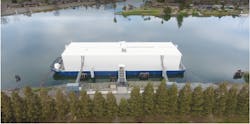Data center sustainability starts before the first shovelful of dirt is turned
Building data centers has pretty much become old hat. The techniques used for construction are well established, the technologies necessary are well-defined, and the processes for the creation of a new facility well documented from beginning to end. So why should my business invest time in reconsidering our approach to the creation of new data centers?
The data center construction world is changing
Nothing is static, and while the IT workload demands placed on a data center are well understood, the newest requirements for data centers are less well established. Sustainability has moved from a "nice to have" to a major focus on new construction. Building data centers that emphasize sustainability has begun to change how we look at data center construction. The focus on delivering more efficient solutions that make data center IT operations more efficient has been ongoing and successful. Technology and operational model changes have succeeded in allowing us to deliver data centers with a major reduction in their environmental impact while increasing the IT workloads that these data centers can support. But a more efficient operational model is only a part of the model, albeit a large and continuous one.
From the perspective of the creation of the data center facility, changes are happening that can allow the delivery of a finished data center to be more sustainable, a factor that businesses need to evaluate to become better corporate citizens. Building sustainability into new data centers from the start means that everything from site selection to opening the doors requires looking at your processes with a different eye than you have in the past. And with this approach, you will find that your data centers can become more cost-effective, providing definable benefits that will improve the corporate bottom line in more easily measured ways.
What to look for and how to find it
Once you have entered the site selection phase for your new facility, your focus on sustainability comes to the fore. The traditional selection criteria are likely no longer appropriate, and the considerations for the site, from environmental impact to infrastructure capabilities, have to go through the sustainability filter. This perspective may change the weights and balances of the different options. Easy accessibility for staff may have significantly less weight than environmental impact. Availability of existing infrastructure, reclamation of brownfield sites, and ease of permitting site construction might significantly outweigh proximity to the most desired locations as planning moves forward.
It's also important to consider data center needs vs data wants. Your initial thought might be that the location merits a full-scale traditional data center, with an impressive 50MW of IT load capability supporting high rack densities with room to grow. But how long will that facility take to build, and what will you be doing in the extended time frame before that site comes online?
There is a good chance that an 8MW to 12MW facility delivered in significantly less time can adequately serve your business needs at that location, offering advantages in cost of construction and future flexibility. And if your first thought is, "I can't get what I need with a containerized or modular data center," it's time to consider the factory-built data center approach. In the Nautilus approach, as much as 70 percent of the data center is built in the factory and delivered to the site, reducing construction time. It also reduces the environmental footprint of the construction in ways you might not have considered. A typical containerized data center deployment would involve about 145 truckloads to get the materials to the site. The same deployment, with almost 3/4ths of the construction done in the factory, only requires 45 truckloads, removing the impact of 100 diesel truckloads being transported to the final construction site. And that's before the site construction even starts, with the significant reduction of on-site construction time and efforts not being factored in.
Sustainability is the future
The media focus on the more negative aspects of the data center construction and operations model isn't going away anytime soon. Taking many of the arguments regularly posed by the press and turning them into positives for what your business is doing to be a good world citizen can bring unexpected benefits. Not only to the business in terms of public acceptance but an ongoing appreciation of the efforts to minimize any negative attributes that might accompany your business growth. Focusing on sustainability, from site selections to construction, to ongoing operations, is a win for both business and community.
Rob Pfleging is CEO & President of Nautilus Data Technologies. Contact them to learn more about meeting your data center sustainability goals. Read the first article in this series here.





